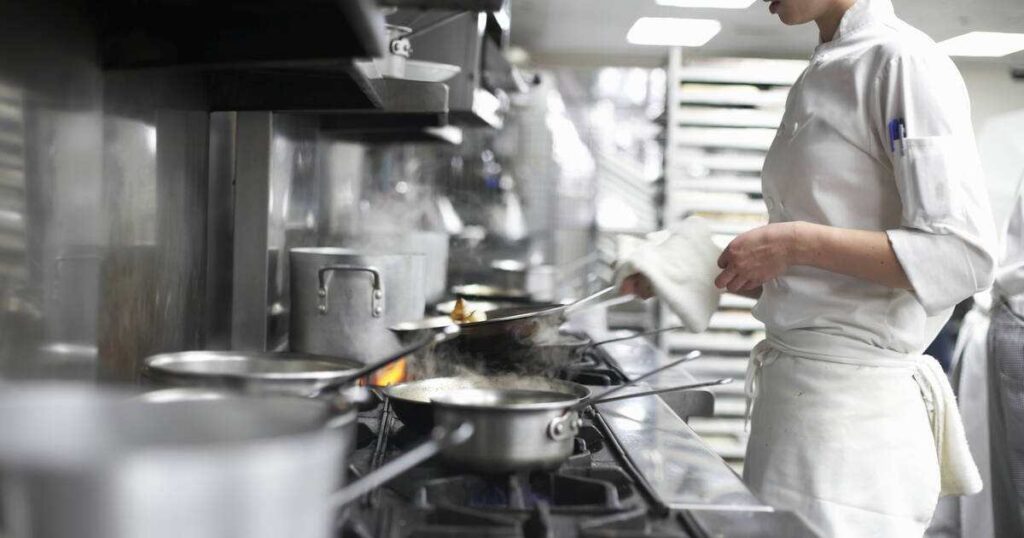Have you heard about ghost kitchens but aren’t quite sure what they are or how they work? You’re not alone! Ghost kitchens, also known as dark kitchens or virtual kitchens, have been gaining popularity in recent years as a game-changer for the food industry.
These delivery-only kitchens are revolutionizing the way we think about restaurants and food delivery.
In this comprehensive guide, we’ll dive deep into the world of ghost kitchens, exploring what they are, how they operate, their benefits, and why they could be the future of food delivery.
Whether you’re a restaurant owner looking to expand your business or a foodie curious about this latest trend, this article has everything you need to know about ghost kitchens, brought to you by the experts at CloudKitchens.
The Lowdown on Ghost Kitchens
The food industry has undergone a significant transformation in recent years, with the rise of online ordering and food delivery services.
As consumer demand for convenience and accessibility continues to grow, ghost kitchens have emerged as a innovative solution for restaurants to meet this demand.
These delivery-only kitchens, optimized solely for takeout and delivery orders, have disrupted the traditional restaurant model, offering a more cost-effective and efficient way to reach customers.
What is a Ghost Kitchen?
A ghost kitchen, also known as a dark kitchen or virtual kitchen, is a commercial kitchen facility that operates without a traditional dine-in space or storefront.
These kitchens are designed exclusively for the preparation of food for delivery or takeout orders, often through third-party delivery platforms like DoorDash, Uber Eats, and Grubhub.
Unlike traditional restaurants, ghost kitchens eliminate the need for a dining room, waitstaff, and other front-of-house operations, allowing restaurant owners to focus solely on producing high-quality food for delivery.
How Do Ghost Kitchens Work?

The concept of a ghost kitchen is relatively straightforward. Restaurant owners or operators rent out a dedicated kitchen space within a larger facility, often located in areas with high delivery demand.
These kitchen spaces are fully equipped with commercial-grade appliances and cooking equipment, allowing operators to prepare their menu items efficiently.
Once set up, the ghost kitchen operates as a virtual restaurant, with customers placing orders through online platforms or delivery apps.
The kitchen staff receives these orders and prepares the food, which is then picked up by delivery drivers and transported to the customer’s location.
This seamless process eliminates the need for a physical storefront, enabling ghost kitchens to operate with lower overhead costs compared to traditional brick-and-mortar restaurants.
What’s the Difference Between a Ghost Kitchen and Delivery at a Brick-and-Mortar?
While many traditional restaurants offer delivery services, ghost kitchens are designed specifically for this purpose, offering several key advantages:
Less Overhead Costs
Ghost kitchens operate without the need for a physical dining space, waitstaff, or other front-of-house operations, significantly reducing overhead costs.
This allows restaurant owners to focus their resources on food production and delivery logistics, potentially increasing profitability.
Optimized for Delivery
Unlike traditional restaurants, where delivery can often be an afterthought, ghost kitchens are built from the ground up to optimize the delivery experience.
This includes streamlined workflows, dedicated pickup areas for delivery drivers, and specialized packaging to ensure food quality during transit.
Simplified Menu Items
Ghost kitchen menus are typically streamlined to feature items that travel well and are easy to prepare for delivery. This not only improves efficiency but also helps to reduce food waste and simplify inventory management.
More Online Traffic
With no physical storefront, ghost kitchens rely solely on online ordering platforms and delivery apps to reach customers.
This allows them to tap into a wider customer base and capitalize on the growing demand for convenient food delivery services.
What Are the Different Types of Ghost Kitchens?
While the core concept of a ghost kitchen remains the same, there are various models and setups to accommodate different restaurant needs:
1. Commissary Kitchens
Commissary kitchens, also known as shared kitchens, are facilities where multiple food businesses can rent out kitchen space on a scheduled basis.
These kitchens are often used by food truck operators, catering companies, or small-scale food producers who require additional prep space but don’t need a dedicated kitchen full-time.
2. Commercial Kitchens
Commercial kitchens, or private kitchens, are dedicated spaces within a larger facility that are leased out to a single restaurant or food business.
These kitchens provide a more permanent and exclusive setup, allowing operators to customize the space to their specific needs.
3. Incubator Kitchens
Incubator kitchens, sometimes referred to as pop-up kitchens, are temporary or short-term kitchen spaces that can be attached to an existing brick-and-mortar restaurant or set up as a standalone unit.
Restaurant owners often use these kitchens to test new concepts, menu items, or delivery strategies without committing to a full-scale ghost kitchen operation.
4. Kitchen Pods
Kitchen pods are modular, self-contained kitchen units that can be easily transported and set up in various locations, such as parking lots or vacant spaces.
These pods are typically smaller in size and may have limited equipment, but they offer a flexible and mobile solution for ghost kitchen operations.
5. CloudKitchens
CloudKitchens is a leading provider of ghost kitchen facilities, offering turn-key solutions for restaurant owners and operators.
Their facilities feature fully equipped commercial kitchens, optimized for delivery operations, as well as on-site support services like order fulfillment and logistics management.
CloudKitchens: How It Works
CloudKitchens has revolutionized the ghost kitchen industry by providing a comprehensive solution for restaurant owners and operators.
Prime Real Estate
One of the biggest advantages of partnering with CloudKitchens is access to prime real estate in high-demand delivery areas.
Their facilities are strategically located in urban centers and densely populated neighborhoods, ensuring maximum exposure to potential customers.
Proprietary Technology
CloudKitchens equips each facility with proprietary technology that streamlines the delivery process.
This includes a single tablet for order management, real-time data analytics, and integration with major delivery platforms, ensuring seamless operations and efficient order fulfillment.
Logistics and Fulfillment
CloudKitchens takes the hassle out of delivery logistics by providing dedicated on-site fulfillment teams.
Once an order is prepared, the team handles the pickup and handoff to the appropriate delivery driver, ensuring timely and accurate deliveries every time.
Facility Management*
In addition to the kitchen spaces, CloudKitchens handles all facility management tasks, including cleaning, maintenance, security, and even a dedicated processing center for order fulfillment.
This comprehensive approach allows restaurant operators to focus solely on creating exceptional food.
How Does a Ghost Kitchen Help Your Restaurant Grow?

The rise of ghost kitchens has opened up numerous opportunities for restaurant growth and expansion, offering several key benefits:
Turn-key Solution
Ghost kitchens provided by CloudKitchens are a true turn-key solution, allowing restaurant owners to launch a delivery-only operation in a matter of weeks, rather than months or years required for a traditional brick-and-mortar setup. This accelerated timeline enables faster growth and quicker access to new markets.
Focus on the Food
By eliminating the need for a physical dining space and front-of-house operations, ghost kitchens allow restaurant owners and chefs to concentrate solely on what they do best – creating delicious food.
This renewed focus on culinary excellence can lead to improved customer satisfaction and increased brand loyalty.
Build Multiple Concepts Out of One Kitchen
One of the most significant advantages of ghost kitchens is the ability to operate multiple virtual restaurant concepts from a single kitchen.
This allows operators to test new menu ideas, cater to different dietary preferences, or even launch entirely new brands, all without the overhead costs of additional brick-and-mortar locations.
Experiment with Low-Risk
Starting a new restaurant concept traditionally carries substantial financial risks, with high upfront costs and no guarantee of success.
Ghost kitchens, however, significantly lower the barrier to entry, enabling restaurant owners to experiment with new ideas and concepts at a fraction of the cost and risk.
Minimize Cost, Maximize Profit
By eliminating the need for a physical dining space and front-of-house staff, ghost kitchens can significantly reduce overhead costs associated with traditional restaurants.
This increased operational efficiency, combined with the ability to reach a wider customer base through delivery platforms, can lead to higher profit margins and improved overall profitability.
Are Ghost Kitchens Profitable?
Ghost kitchens have proven highly profitable for restaurant owners by minimizing overhead costs and capitalizing on the booming food delivery market.
Key advantages include significantly reduced expenses without a physical dining space or front-of-house staff. Additionally, there is the ability to efficiently reach a broader customer base through delivery platforms, and the flexibility to operate multiple virtual restaurant concepts from one kitchen.
Ghost kitchens benefit from streamlined operations, data-driven insights for menu optimization and inventory management, and the potential for higher profit margins compared to traditional brick-and-mortar restaurants.
While initial investment varies, many operators achieve profitability within their first year by tapping into convenient delivery demand with lower risks and overhead.
Success requires effective marketing, operational efficiency, and consistent quality.
Overall, the ghost kitchen model presents a compelling opportunity to profitably meet the growing appetite for food delivery convenience. It minimizes costs and reduces the complexities associated with traditional restaurants.
How Do You Start a Ghost Kitchen?
Starting a ghost kitchen seems daunting, but CloudKitchens provides a comprehensive solution to launch delivery-only businesses easily.
They guide the entire process – securing prime real estate locations, setting up the kitchen with permits and equipment, integrating proprietary technology for seamless operations, branding/marketing support, and on-site fulfillment teams.
A key advantage is the ability to launch within weeks instead of months, quickly tapping into the lucrative delivery market. Their model offers flexibility to scale up by adding kitchen spaces or new virtual brands as the business grows.
With CloudKitchens’ expertise and resources, restaurant owners can navigate the complexities of ghost kitchens and position themselves for success in the rapidly growing delivery industry through this highly rewarding and profitable venture.
Also Read This Post:
How To Organize Kitchen Cabinets?
FAQ’s
Are ghost kitchens only for delivery?
Yes, ghost kitchens are primarily designed for delivery and takeout orders, without a dedicated dine-in space or customer-facing operations.
Can I run multiple restaurant concepts from a single ghost kitchen?
Absolutely! One of the key advantages of ghost kitchens is the ability to operate multiple virtual restaurant brands or concepts from a single kitchen facility.
How do ghost kitchens handle food safety and quality control?
Ghost kitchens must adhere to the same food safety regulations and quality control standards as traditional restaurants. Many ghost kitchen providers, like CloudKitchens, have stringent protocols in place to ensure food safety and quality.
Is it difficult to market a ghost kitchen without a physical location?
While marketing a ghost kitchen does require a different approach, providers like CloudKitchens offer support in branding, menu design, and online marketing strategies to help reach your target audience effectively.
Can I expand my ghost kitchen operation as my business grows?
Yes, the ghost kitchen model is highly scalable.
As your business grows, you can easily expand to additional kitchen spaces. You can also launch new virtual restaurant concepts, leveraging the existing infrastructure and support provided by companies like CloudKitchens.
Final Thoughts
Ghost kitchens, or virtual kitchens, have emerged as a game-changing concept in the food industry, offering a unique solution to meet the growing demand for convenient and accessible food delivery services.
By eliminating the need for a physical storefront and focusing solely on delivery and takeout orders, ghost kitchens provide restaurant owners and operators with a cost-effective and efficient way to reach customers.
Whether you’re a seasoned restaurateur or an aspiring entrepreneur, the ghost kitchen model presents a compelling opportunity to tap into the lucrative food delivery market while minimizing overhead costs and operational complexities.
With the support of industry leaders like CloudKitchens, launching and growing a successful ghost kitchen business has never been more achievable.







